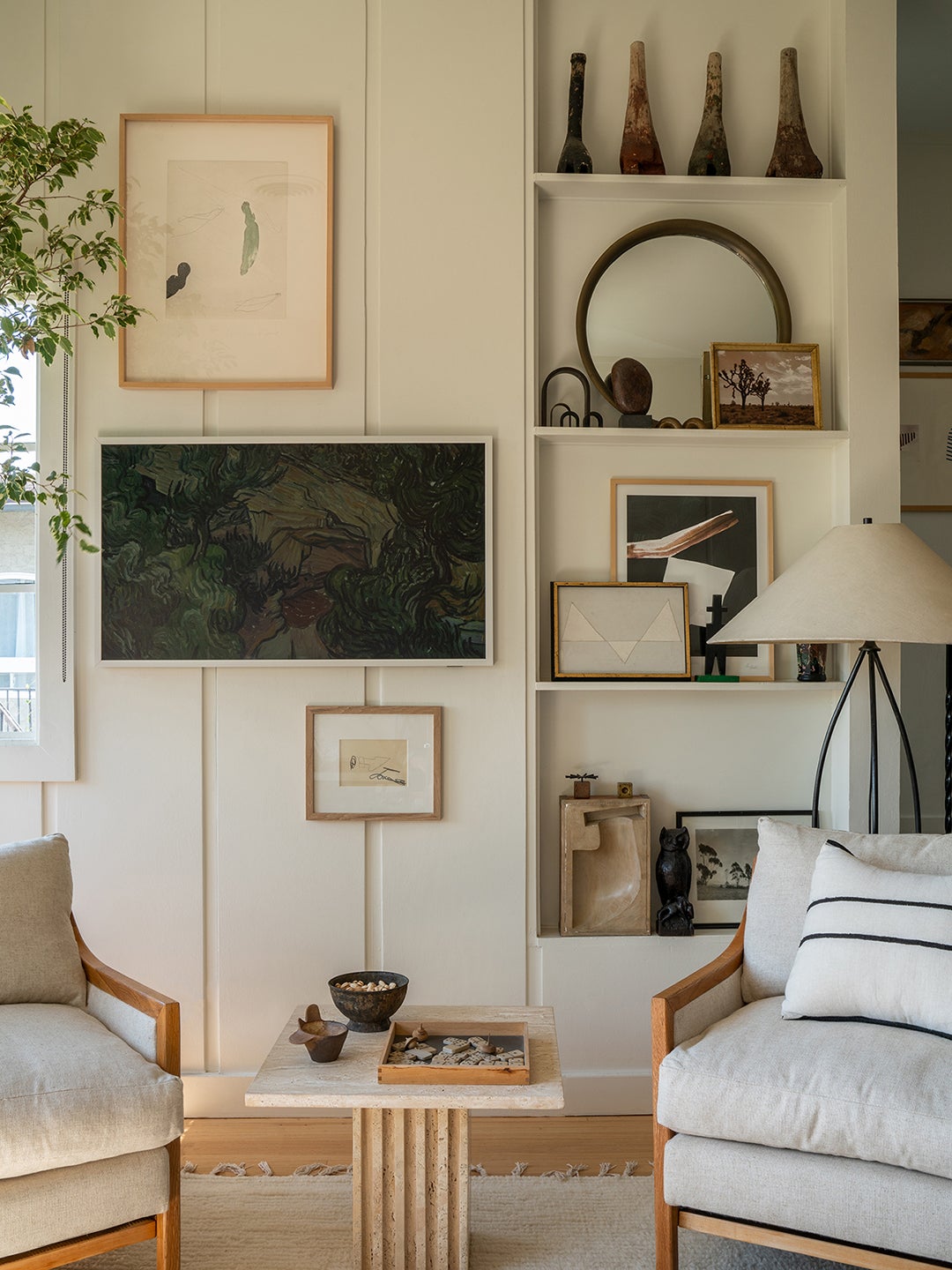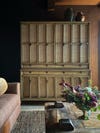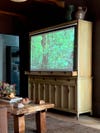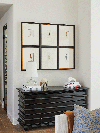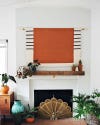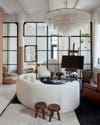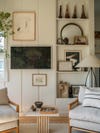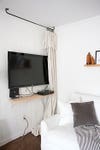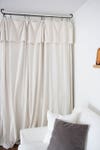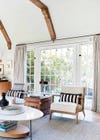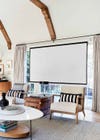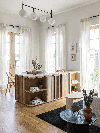17 Ways to Hide Your TV in Plain Sight
Including two uses for a drop cloth.
Updated Oct 18, 2023 8:54 AM
We may earn revenue from the products available on this page and participate in affiliate programs.
“Televisions are a necessary evil for interior designers,” says Christina Valencia, one half of the husband-and-wife studio Colossus Mfg. Most of their clients want to have one in their living space, but the practical place for it always seems to be right in the middle of the room. The result? When you’re not streaming or hosting Super Bowl Sunday, you’re left looking at a big black box. No matter how cool your media console or how chic your sectional, no amount of style can completely turn your head from the eyesore. Fortunately, this all-too-common dilemma has forced designers to get creative with temporarily disguising the tricky tech when it’s powered off, and surprisingly most of their solutions are easy to DIY. Here’s how to hide your TV, 17 different ways.
Make It Flush
In her own home, designer Montana Labelle created a drywall niche for her TV to sit in and simply added swinging doors made out of MDF that are covered in the same Venetian plaster that Studio Apostolos applied to the walls. The fronts are push-to-open with concealed Tectus hinges, so it nearly looks invisible.
Camouflage It With Wallpaper
The flush TV cabinet and wall in this Oakland Hills, California, home, designed by Medium Plenty, is swathed in Elworthy Studio’s Botanica print. Looking at the treatment is almost as thrilling as watching a murder mystery show: The artist created a series of poppy flowers by dipping an art blade into ink and making layered petals with one hand and spraying water onto the paper with her other hand. The ink and water interact differently each time, resulting in a fluid motif.
Surround the Cabinet With Paneling
If you think the seam in a TV cabinet looks too obvious, trick the eye by adding more linear elements to the walls around it. In this Dallas home, designers Hayley Cavagnolo and Alex Boudreau introduced a board-and-batten system to give the space character and distract you from the box over the fireplace.
Layer Artwork Over a Samsung Frame TV
Brigette Muller, the creative behind the home decor account @hummusbird, openly admits that she doesn’t watch a lot of TV, so mounting her Frame in an unusual spot (it’s that one directly underneath the bookshelf!) seemed like a suitable enough position, especially when she is lying horizontal on her sofa. To really disguise it, though, she opted for an elaborate gold border (you can buy a similar-looking one on Amazon). That way, when she sets the screen saver to an oil painting and leans actual similar works against it, her living room feels more like an artist’s studio than it does a place for bingeing Succession.
Pull Up the Big Screen
Lone Fox Home creator Drew Scott connected the drawers in the center of this vintage hutch to form a cubby that can hold a roll-up screen. When movie night comes around, Scott can simply draw it up and attach it to a hook he placed on the top.
Stash It Behind Slatted Wood
The thought process that led to this stained white oak cabinet, designed by Hyphen and Co. and the project’s lead designer, Eliza McNabb, was twofold: When hosting, guests are constantly walking through the den to get to the kitchen and main hallway, so it allows the space to feel more elevated when it’s not turned on. The homeowners also use the house during the summer months, when they spend much of their time outside, so having the option to close the unit keeps the focus on nature and spending time together.
Artfully, Open Sesame
Pulp Design Studios made a clever hideaway for a client’s rarely used television by setting the screen into the wall and adding “doors” on either side. When closed, all guests see are six works of art in matching frames.
Embrace Your Inner Van Gogh
Valencia and her husband, Kele Dobrinski, took a similar approach by putting the TV in Dobrinski’s parents’ home in a cabinet. Rather than hunting down prints at an antiques shop, though, they painted an abstract landscape onto the facade.
Shroud It With Scrap Textiles
Designer Alex Boudreau happens to have a “ridiculous collection” of 1-yard fabric samples, so when she feels like hiding her eye-level, wall-mounted TV, she just throws her favorite one of the month over it.
Put an Old Rug to Use
Often the only logical place to situate the tech is directly over the fireplace—a no-no in the design world, as it takes away from the gathering and conversing that a roaring fire encourages. That’s why Los Angeles–based creative director, stylist, and photographer Kristin Guy was determined to mask hers with a five-minute DIY that calls for a flat-weave rug, a dowel, and a couple of sturdy hooks.
Lean It on an Easel
New York designer Crystal Sinclair decided to leave her client’s Frame TV out in the open in her Brooklyn loft—but by positioning it on an antique easel instead of a traditional media console, it takes on the role of art rather than atrocity. Wright will fool people into thinking it’s a real painting by throwing on a screen saver, as is intended with the Samsung product.
Mix the Frame TV Into a Gallery Wall
Another smart way to make the most of the Frame TV: Work it into a gallery wall like interior stylist Scott Horne did in his L.A. living room. The original wide wall paneling (now painted in Benjamin Moore’s White Dove) adds a layer of dimension that further helps the 3D box blend into the background.
Shield It With a Drop Cloth, Two Ways
DIYer and blogger Emily Brownell took a drop cloth outside, primed it, and painted abstract shapes on the canvas using leftover sample jars and oil pastels she had lying around her house. The large-scale tapestry now hangs from a dowel that’s mounted to the ceiling in her garage-turned-den. When it’s movie night, all the family has to do is lift the fabric and push it behind the TV.
Seeking Lavender Lane blogger Deb Foglia not only needed to hide her screen but the unsightly cable box and cords attached to it. So after mounting it all on the only blank wall in her space, she screwed a curtain rod into the ceiling, popped on two rings, and finished off the disguise with a 9-by-12-foot drop cloth.
Take a Moment to Reflect
Things get even trickier when you’re trying to obscure a television in a room where you usually don’t expect to see one. Following her client’s request for a secret screen in the dining room, designer Maggie Burns opted for a Reflectel, a custom framed TV that, when turned off, is concealed by mirror glass.
Go Big When You Go Home
If a discreet home theater is what you’re after, take a cue from Emily Henderson and install a projector with a simple white cartridge (hers is mounted on the ceiling above her sofa) and a pull-down screen (located above the window). All the cords are hidden behind the shades or within white cord covers that her installer snaked down the middle of the windows.
Think: What Would James Bond Do?
After realizing this apartment only had one wall available for artwork, designer Charlotte Sylvain of Studio Fauve decided to position the TV in the middle of the room. The custom floating dining banquette–meets–media console comes with a remote-controlled lift that conceals (or reveals) the flat screen at the touch of a button.
